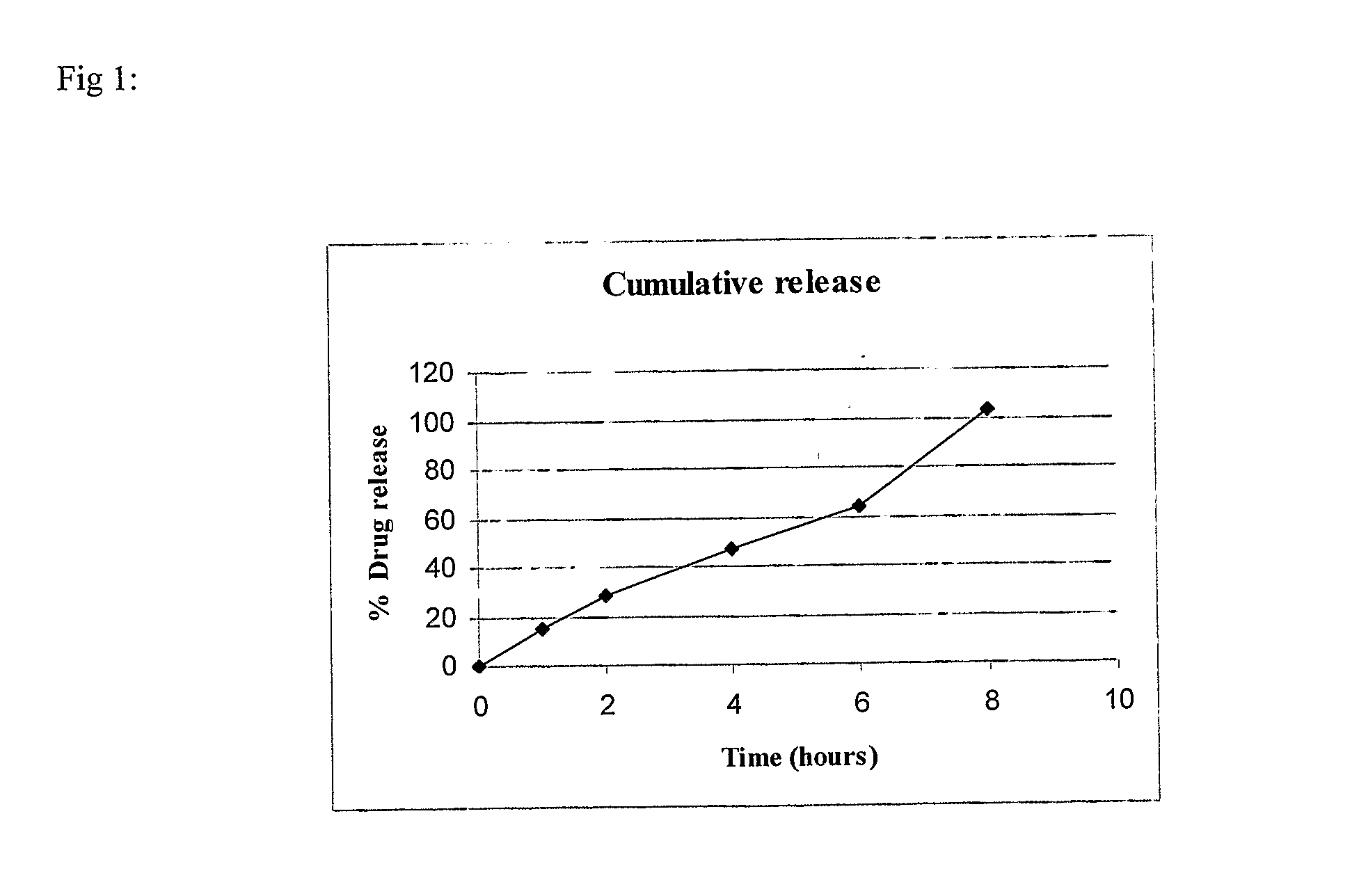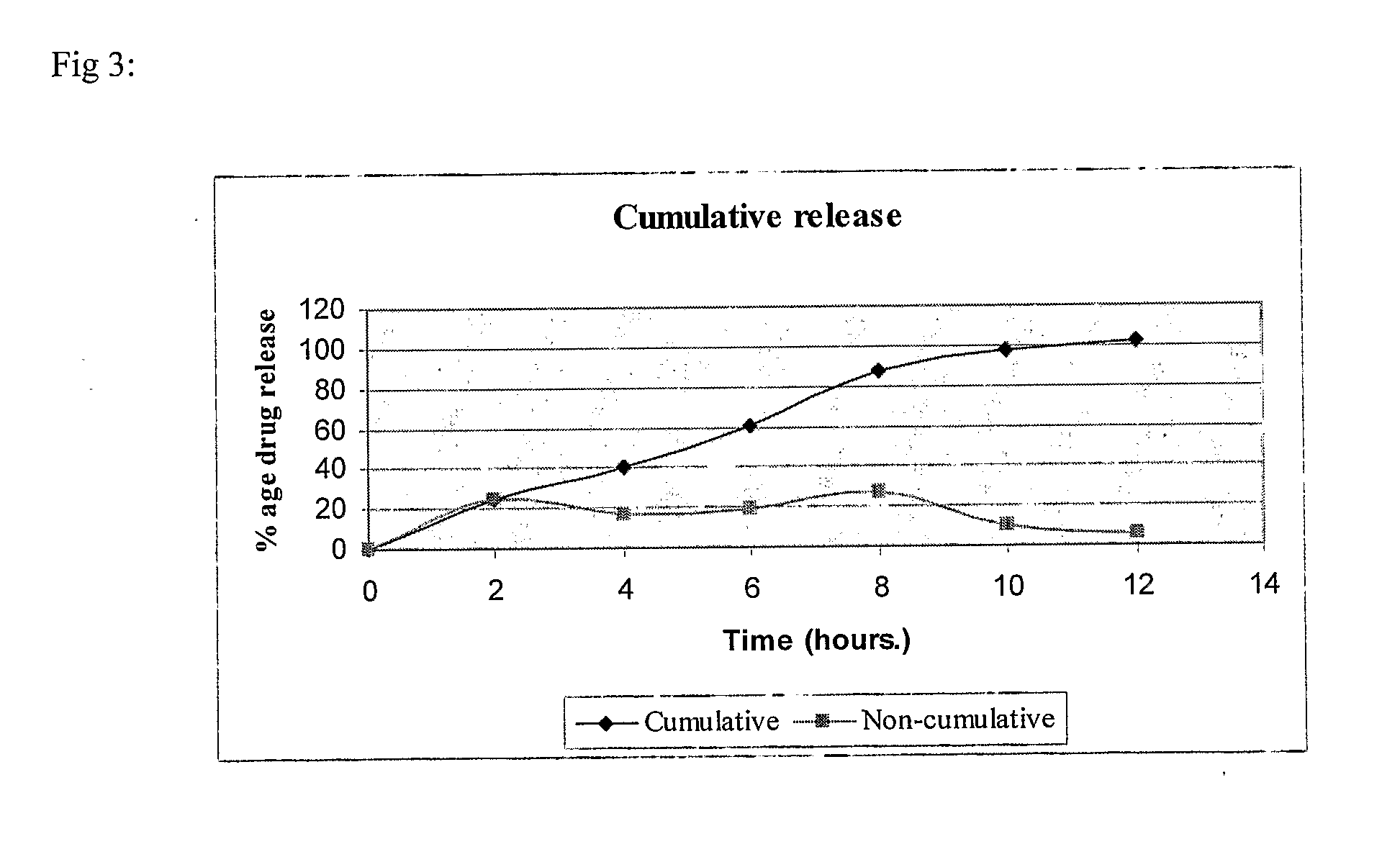Modified release pharmaceutical compositions comprising mycophenolate and processes thereof
a technology of mycophenolate and pharmaceutical compositions, which is applied in the direction of biocide, plant growth regulators, animal husbandry, etc., can solve the problems of lack of patient compliance, variable and unpredictable release of active agents from such compressed forms, unpleasant and gritty mouth feeling, etc., to maintain prophylactic and/or therapeutic levels, easy and cost-effective
- Summary
- Abstract
- Description
- Claims
- Application Information
AI Technical Summary
Benefits of technology
Problems solved by technology
Method used
Image
Examples
example-1
(80:20) SR:IR
[0084]
S. No.IngredientQuantity / tablet (mg)Sustained Release (SR) Layer1.Mycophenolate sodium630.98(equivalent to 576 mg ofmycophenolic acid)2.Lactose DCL215.53.Aerosil 200150.024.Polyvinyl pyrrolidone55(PVP K-90)5.Hydroxypropyl methyl55cellulose6.Polyethylene oxide110(Polyox WSR 301)7.Polyvinyl pyrrolidone27.5(PVP K-30)8.Isopropyl alcoholq.s.(lost in processing)9.Magnesium stearate10.5Immediate Release (IR) Layer10.Mycophenolate sodium158.3(equivalent to 148 mgof mycophenolic acid)11.Microcrystalline cellulose44(Avicel ® PH 101)12.Polyvinyl pyrrolidone2.2(PVP K-30)13.Isopropyl alcoholq.s.(lost in processing)14.Magnesium stearate2.2
Procedure:
[0085]i) Mycophenolate sodium, lactose anhydrous, colloidal silicon dioxide, polyethylene oxide, hydroxypropyl methyl cellulose and polyvinyl pyrrolidone (PVP K-90) were weighed and passed through #30 s.s. sieve and mixed for 5 mins.[0086]ii) PVP K-30 was dissolved in Isopropyl alcohol and the dispersion was used to granulate the mat...
example 2
(80:20) SR:IR
[0097]
S. No.IngredientQuantity / tablet (mg)Sustained Release (SR) Layer1.Mycophenolate sodium630.98(equivalent to 576 mgmycophenolic acid)2.Lactose DCL215.53.Aerosil 200150.024.Polyvinyl pyrrolidone (PVP K-90)555.Hydroxypropyl methyl cellulose556.Polyethylene oxide (Polyox WSR 301)1107.Polyvinyl pyrrolidone (PVP K-30)27.58.Isopropyl alcoholq.s.(lost in processing)9.Magnesium stearate10.5Immediate Release (IR) Layer10.Mycophenolate sodium158.3(equivalent to 148 mgof mycophenolic acid)11.Starch 15004212.Succinic acid2213.Polyvinyl pyrrolidone (PVP K-30)2.514.Isopropyl alcoholq.s.(lost in processing)15.Magnesium stearate2.5
Procedure:
[0098]i) Mycophenolate sodium, lactose anhydrous, colloidal silicon dioxide, polyethylene oxide, hydroxypropyl methyl cellulose, polyvinyl pyrrolidone (PVP K-90) and starch 1500 were weighed and passed through #30 s.s. sieve and mixed for 5 mins.[0099]ii) PVP K-30 was dissolved in Isopropyl alcohol and the dispersion was used to granulate the ma...
example 3
(80:20) SR:IR
[0110]
S. No.IngredientQuantity / tablet (mg)Sustained Release (SR) Layer1.Mycophenolate sodium630.98(equivalent to 576 mgof mycophenolic acid)2.Lactose DCL2122.73.Aerosil 20054.Polyvinyl pyrrolidone (PVP K-90)255.Hydroxypropyl methyl cellulose1506.Polyethylene oxide (Polyox WSR 301)257.Polyvinyl pyrrolidone (PVP K-30)108.Isopropyl alcoholq.s.(lost in processing)9.Magnesium stearate1010.Hydroxypropyl methyl cellulose5511.Cetostearyl Alcohol11012.Magnesium stearate10.5Immediate Release (IR) Layer13.Mycophenolate sodium158(equivalent to 148 mgof mycophenolic acid)14.Lactose DCL215.415.Succinic acid2016.Kollidon CLM1017.Polyvinyl pyrrolidone (PVP K-30)718.Isopropyl alcoholq.s.(lost in processing)
Procedure:
[0111]i) Mycophenolate sodium, lactose anhydrous, colloidal silicon dioxide, polyethylene oxide, hydroxypropyl methyl cellulose and polyvinyl pyrrolidone (PVP K-90) were weighed and passed through #30 s.s. sieve and mixed for 5 mins.[0112]ii) PVP K-30 was dissolved in Isopro...
PUM
| Property | Measurement | Unit |
|---|---|---|
| concentration | aaaaa | aaaaa |
| concentration | aaaaa | aaaaa |
| concentrations | aaaaa | aaaaa |
Abstract
Description
Claims
Application Information
 Login to View More
Login to View More - R&D
- Intellectual Property
- Life Sciences
- Materials
- Tech Scout
- Unparalleled Data Quality
- Higher Quality Content
- 60% Fewer Hallucinations
Browse by: Latest US Patents, China's latest patents, Technical Efficacy Thesaurus, Application Domain, Technology Topic, Popular Technical Reports.
© 2025 PatSnap. All rights reserved.Legal|Privacy policy|Modern Slavery Act Transparency Statement|Sitemap|About US| Contact US: help@patsnap.com



